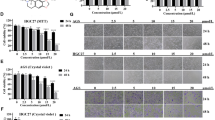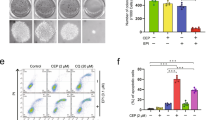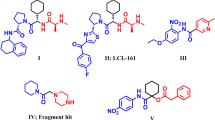Abstract
Aim:
To investigate the molecular mechanisms underlying the antitumor activity of cepharanthine (CEP), an alkaloid extracted from Stephania cepharantha Hayata.
Methods:
Human osteosarcoma cell line SaOS2 was used. MTT assay, Hoechst 33342 nuclear staining, flow cytometry, Western blotting and nude mouse xenografts of SaOS2 cells were applied to examine the antitumor activity of CEP in vitro and in vivo. The expression levels of STAT3 and its downstream signaling molecules were measured with Western blotting and immunochemistry analysis. The activity of STAT3 was detected based on the phosphorylation level of STAT3, luciferase gene reporter assay and translocation of STAT3 to the nucleus.
Results:
Treatment of SaOS2 cells with CEP (2.5–20 μmol/L) inhibited the cell growth in a concentration- and time-dependent manner. CEP (10 μmol/L) caused cell cycle arrest at G1 phase and induced apoptosis of SaOS2 cells. CEP (10 and 15 μmol/L) significantly decreased the expression of STAT3 in SaOS2 cells. Furthermore, CEP (5 and 10 μmol/L) significantly inhibited the expression of target genes of STAT3, including the anti-apoptotic gene Bcl-xL and the cell cycle regulators c-Myc and cyclin D1. In nude mouse xenografts of SaOS2 cells, CEP (20 mg·kg−1·d−1, ip for 19 d) significantly reduced the volume and weight of the tumor.
Conclusion:
Our findings suggest that inhibition of STAT3 signaling pathway is involved in the anti-tumor activity of CEP.
Similar content being viewed by others
Log in or create a free account to read this content
Gain free access to this article, as well as selected content from this journal and more on nature.com
or
References
Kimoto T, Suemitsu K, Nakayama H, Komori E, Ohtani M, Ando S . Therapeutic experience of venomous snakebites by the Japanese viper (Agkistrodon halys Blomhoffii) with low dose of antivenin: report of 43 consecutive cases. Nippon Geka Hokan 1997; 66: 71–7.
Morita K, Nakamura M, Nagamachi M, Kishi T, Miyachi Y . Seventeen cases of alopecia areata: combination of SADBE topical immunotherapy with other therapies. J Dermatol 2002; 29: 661–4.
Furusawa S, Wu J . The effects of biscoclaurine alkaloid cepharanthine on mammalian cells: implications for cancer, shock, and inflammatory diseases. Life Sci 2007; 80: 1073–9.
Goto M, Zeller WP, Hurley RM . Cepharanthine (biscoclaurine alkaloid) treatment in endotoxic shock of suckling rats. J Pharm Pharmacol 1991; 43: 589–91.
Mukai M, Che XF, Furukawa T, Sumizawa T, Aoki S, Ren XQ, et al. Reversal of the resistance to STI571 in human chronic myelogenous leukemia K562 cells. Cancer Sci 2003; 94: 557–63.
Shiraishi N, Akiyama S, Nakagawa M, Kobayashi M, Kuwano M . Effect of bisbenzylisoquinoline (biscoclaurine) alkaloids on multidrug resistance in KB human cancer cells. Cancer Res 1987; 47: 2413–6.
Fujimura T, Shibata H, Maekawa I, Furusawa S, Kawauchi H, Sasaki K, et al. Reversal of resistance to doxorubicin with cepharanthine in murine P388 leukemia cells. Jpn J Pharmacol 1990; 54: 464–7.
Seubwai W, Vaeteewoottacharn K, Hiyoshi M, Suzu S, Puapairoj A, Wongkham C, et al. Cepharanthine exerts antitumor activity on cholangiocarcinoma by inhibiting NF-kappaB. Cancer Sci 2010; 101: 1590–5.
Wu J, Suzuki H, Zhou YW, Liu W, Yoshihara M, Kato M, et al. Cepharanthine activates caspases and induces apoptosis in Jurkat and K562 human leukemia cell lines. J Cell Biochem 2001; 82: 200–14.
Biswas KK, Tancharoen S, Sarker KP, Kawahara K, Hashiguchi T, Maruyama I . Cepharanthine triggers apoptosis in a human hepatocellular carcinoma cell line (HuH-7) through the activation of JNK1/2 and the downregulation of Akt. FEBS Lett 2006; 580: 703–10.
Murakami K, Okajima K, Uchiba M . The prevention of lipopolysaccharide-induced pulmonary vascular injury by pretreatment with cepharanthine in rats. Am J Respir Crit Care Med 2000; 161: 57–63.
Murakami K, Cox RA, Hawkins HK, Schmalstieg FC, McGuire RW, Jodoin JM, et al. Cepharanthin, an alkaloid from Stephania cepharantha, inhibits increased pulmonary vascular permeability in an ovine model of sepsis. Shock 2003; 20: 46–51.
Okamoto M, Ono M, Baba M . Potent inhibition of HIV type 1 replication by an antiinflammatory alkaloid, cepharanthine, in chronically infected monocytic cells. AIDS Res Hum Retroviruses 1998; 14: 1239–45.
Azuma M, Aota K, Tamatani T, Motegi K, Yamashita T, Ashida Y, et al. Suppression of tumor necrosis factor alpha-induced matrix metalloproteinase 9 production in human salivary gland acinar cells by cepharanthine occurs via down-regulation of nuclear factor kappaB: a possible therapeutic agent for preventing the destruction of the acinar structure in the salivary glands of Sjogren's syndrome patients. Arthritis Rheum 2002; 46: 1585–94.
Harada K, Ferdous T, Itashiki Y, Takii M, Mano T, Mori Y, et al. Cepharanthine inhibits angiogenesis and tumorigenicity of human oral squamous cell carcinoma cells by suppressing expression of vascular endothelial growth factor and interleukin-8. Int J Oncol 2009; 35: 1025–35.
Tamatani T, Azuma M, Motegi K, Takamaru N, Kawashima Y, Bando T . Cepharanthin-enhanced radiosensitivity through the inhibition of radiation-induced nuclear factor-kappaB activity in human oral squamous cell carcinoma cells. Int J Oncol 2007; 31: 761–8.
Bollrath J, Greten FR . IKK/NF-kappaB and STAT3 pathways: central signalling hubs in inflammation-mediated tumour promotion and metastasis. EMBO Rep 2009; 10: 1314–9.
Jing N, Tweardy DJ . Targeting Stat3 in cancer therapy. Anticancer Drugs 2005; 16: 601–7.
Grivennikov SI, Karin M . Dangerous liaisons: STAT3 and NF-kappaB collaboration and crosstalk in cancer. Cytokine Growth Factor Rev 2010; 21: 11–9.
Yang J, Liao X, Agarwal MK, Barnes L, Auron PE, Stark GR . Unphosphorylated STAT3 accumulates in response to IL-6 and activates transcription by binding to NFkappaB. Genes Dev 2007; 21: 1396–408.
Lin S, Li S, Chen Z, He X, Zhang Y, Xu X, et al. Formation, recognition and bioactivities of a novel G-quadruplex in the STAT3 gene. Bioorg Med Chem Lett 2011; 21: 5987–91.
Ryu K, Susa M, Choy E, Yang C, Hornicek FJ, Mankin HJ, et al. Oleanane triterpenoid CDDO-Me induces apoptosis in multidrug resistant osteosarcoma cells through inhibition of Stat3 pathway. BMC Cancer 2010; 10: 187.
Zhang H, Feng W, Liao W, Ma X, Han Q, Zhang Y . The gp130/STAT3 signaling pathway mediates beta-adrenergic receptor-induced atrial natriuretic factor expression in cardiomyocytes. FEBS J 2008; 275: 3590–7.
Fu S, Kurzrock R . Development of curcumin as an epigenetic agent. Cancer 2010; 116: 4670–6.
Lin JK, Pan MH, Lin–Shiau SY . Recent studies on the biofunctions and biotransformations of curcumin. Biofactors 2000; 13: 153–8.
Takahashi-Makise N, Suzu S, Hiyoshi M, Ohsugi T, Katano H, Umezawa K, et al. Biscoclaurine alkaloid cepharanthine inhibits the growth of primary effusion lymphoma in vitro and in vivo and induces apoptosis via suppression of the NF-kappaB pathway. Int J Cancer 2009; 125: 1464–72.
Ito H, Amano H, Noda H . Inhibitory effect of a biscoclaurine alkaloid, cepharanthin, on lung metastasis of Lewis lung carcinoma. Jpn J Pharmacol 1991; 56: 195–202.
Kikukawa Y, Okuno Y, Tatetsu H, Nakamura M, Harada N, Ueno S, et al. Induction of cell cycle arrest and apoptosis in myeloma cells by cepharanthine, a biscoclaurine alkaloid. Int J Oncol 2008; 33: 807–14.
Ono M . Antitumor effect of cepharanthin — mechanism of the antimetastatic effect on Lewis lung carcinoma (3LL). Gan To Kagaku Ryoho 1988; 15: 249–55.
Ebina T, Ishikawa K, Murata K . Antitumor effect of Cepharanthin in the double grafted tumor system. Gan To Kagaku Ryoho 1990; 17: 1165–71.
Deorukhkar A, Krishnan S . Targeting inflammatory pathways for tumor radiosensitization. Biochem Pharmacol 2010; 80: 1904–14.
Yu H, Pardoll D, Jove R . STATs in cancer inflammation and immunity: a leading role for STAT3. Nat Rev Cancer 2009; 9: 798–809.
Ryu K, Choy E, Yang C, Susa M, Hornicek FJ, Mankin H, et al. Activation of signal transducer and activator of transcription 3 (Stat3) pathway in osteosarcoma cells and overexpression of phosphorylated-Stat3 correlates with poor prognosis. J Orthop Res 2010; 28: 971–8.
Bowman T, Garcia R, Turkson J, Jove R . STATs in oncogenesis. Oncogene 2000; 19: 2474–88.
Acknowledgements
This project was supported by the National Natural Science Foundation (81070196), the Natural Science Foundation of Beijing (7082101), and Program for New Century Excellent Talents in University and Beijing Talents Foundation (BMU20100012).
Author information
Authors and Affiliations
Corresponding author
Rights and permissions
About this article
Cite this article
Chen, Z., Huang, C., Yang, Yl. et al. Inhibition of the STAT3 signaling pathway is involved in the antitumor activity of cepharanthine in SaOS2 cells. Acta Pharmacol Sin 33, 101–108 (2012). https://doi.org/10.1038/aps.2011.164
Received:
Accepted:
Published:
Issue date:
DOI: https://doi.org/10.1038/aps.2011.164
Keywords
This article is cited by
-
Research on architecture of multi-type sand bodies inside distributary channel of delta plain: a case study in the Daniudi Gas Field, Ordos Basin
Arabian Journal of Geosciences (2022)
-
Chinese Herbal Medicine for Osteosarcoma in the Mouse: A Systematic Review and Meta-Analysis
Chinese Journal of Integrative Medicine (2019)
-
The anti-hyperglycemic efficacy of a lipid-lowering drug Daming capsule and the underlying signaling mechanisms in a rat model of diabetes mellitus
Scientific Reports (2016)
-
Icaritin suppresses the proliferation of human osteosarcoma cells in vitro by increasing apoptosis and decreasing MMP expression
Acta Pharmacologica Sinica (2014)
-
Biologic activity of the novel small molecule STAT3 inhibitor LLL12 against canine osteosarcoma cell lines
BMC Veterinary Research (2012)



